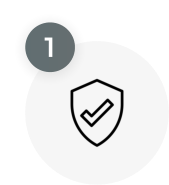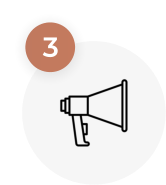So you’ve thought about it long and hard for a while now, and you’ve finally come to the big decision. You want a new website.
That’s brilliant. Everyone loves new things! Now what?
Well, the next question is what is your new website for? It’s general knowledge that when clients come to us asking for a new website, we know that they want it to be the best. No, not the best, they want it to be the most brilliant, extravagant, prettiest, hard-working website out there. That’s brilliant too; no designer enjoys making boring bog-standard websites. But, I ask again, what is your website for?
Who’s your audience?
Before any project is started, a good designer needs to know what your business is about and who your target audience is. If a web designer doesn’t ask you those two small but mighty questions then you can say goodbye to having the most brilliant, extravagant, prettiest and hard-working website out there. Your website is only going to be the best if your target audience can firstly, find it and secondly, like it and use it.
So, before the design work can even begin, you must know the answer to those two questions. Homepages should be focused, speaking to the right people in the correct language. If the design isn’t built around who you’re targeting then your audience isn’t going to feel engaged with your website, leading to them leaving it and feeling very insignificant.
Focus on your content
Content. I can hear your sighs already but you’re just going to have to grit your teeth and accept it.
Content is everything, now more than ever. If you’ve read our previous blog posts then you’ll know how much we harp on about content. Trust me, we don’t do it for our own entertainment! Content is the story on your website, it’s the images you take and upload, it’s the blog posts you create and share – it is literally everything.
It’s also what Google sees. Do I have your attention about it now? Without content on a website, Google won’t notice it. In turn, Google loves a website with regular updates and news (i.e, an active blog). The more active a website is, the more resourceful and reliable Google sees your website. Check out one of our blog posts from our SEO expert Lionel about how Google actually prefers content over SEO.
Whilst content is just fantastic all-round, make sure it’s not written for the search engine bots. Bots won’t buy your product, nor will they give you an income. Always tailor your content for your audience.
Don’t skimp on imagery
Imagery is a very important aspect of a well-designed website. The big trends right now are parallex scrolling combined with big, powerful pictures or graphics. For these kinds of designs to be effective to the right audience, the pictures that you use must be clean and crisp. Looking at a large, blown up image with low resolution is enough to hurt anyone’s head. It’s not satisfying and it’s incredibly frustrating. If you know that you want lots of big, beautiful pictures then firstly, know what pictures you want. When you know what you’re looking for, the task of finding them becomes much easier. There are plenty of resources online for free, unlicensed photos (a new favourite of mine is Unsplash) if you don’t have the facilities to take the pictures yourself.
If all else fails, hire a photographer. I know, it’s a hassle, it’s expensive and it’s just an out-right inconvenience. But I promise you, the end results are totally worth it.
Take a quick look below at a few examples of websites using beautiful, big, powerful images on their homepages:



Remember to include an action
A good, functioning website caters to every aspect within its target audience; those that are ready to buy and those that want to think about it a little more. Therefore, a good, functioning homepage has a Call to Action (CTA) which asks the visitor to do something. These can range from wanting visitors to fill out an enquiry form, to getting them to sign up to your email newsletter.
The goal of the homepage is to encourage visitors to delve deeper and find out more, moving further down the sales funnel. CTA’s direct and guide a visitor, telling them what to do next.
Take a quick look below for some brilliant examples of CTA in action!




Usability
Usability is crucial. It goes without saying that any website that’s built now should be mobile responsive. A website that has quick load time, smooth operation and is responsive to any mobile device is onto a winner.
It’s also important that your website is compatible with different browsers and their older versions. Unfortunately not everyone regularly updates their browser, so if your snazzy new website can’t load for a handful of visitors who have older browsers then that’s possible income that you’ll never know you’re missing out on.
Keep it simple
Nothing ruins a visitors’ web experience more than clutter. It’s horrible, we all hate it. Too much of something in this instance is definitely not good for us and it’s definitely not good for your brand. A cluttered website can give the impression that the business is unorganised and can make visitors run for the hills.
Having a lot of content is brilliant for a business, just be mindful about how it’s displayed. A homepage should have a focal point and your CTA’s should help guide the visitor through your website. If there’s too much going in then visitors won’t know where to click and they’ll give up and leave.
Clear navigation
One of the most frustrating experiences a user can have on a website is being unable to figure out where to go, let alone where they are. Great navigation is easy and accessible. Buttons should be clear as to where they take you to and the menu must be easy to find. Visitors didn’t come to your website to be made to feel stupid so don’t let them.
Larger sites may use bread crumb trails if it’s easy for visitors to get lost amongst their pages.
Keep a clean theme
Consistency is all about making everything match. The heading sizes, the fonts used, the colours picked, spacing, button styles, illustration styles, photo choices etc. A website must have a consistent theme which promotes a brand’s image and feel.
For example, it would make sense for a child nursery’s website to use primary colours, crayon drawings and big, fun text. Now, it wouldn’t make sense for a care home’s website to use this theme. Any good web designer will look at the target audience and find the best way to appeal to them through design.
Remember, spacing is OK
There are several types of space to consider when the word “spacing” is used.
Firstly, line spacing. The space between the lines affects how readable your content appears. Too little space make it easy for readers to glaze over your precious content and too much space means that when you’ve finished reading one line, it’s tricky for your eye to find the next line to read.
Second type of spacing is padding. Padding is the space between elements (images, tables, borders etc) and text. It’s a general rule that text content shouldn’t touch other elements, so there should always be padding.
Our last but most important (and misunderstood) type of spacing is white space.
Ahh, the dreaded white space. It’s like marmite, people either love it or hate it. If you’re not familiar with the term white space then I’m referring to the empty space on a page (often called negative space, too). White space is used to provide balance, contrast and proportion to a website. Elegant, up-market businesses tend to use a fair amount of white space on their website because minimal design exudes a sense of refinery.
The next time you stumble across a mesmerising website…
Stop for a moment to appreciate it. Think about what makes it beautiful and if you’re who it’s targeted at. What text makes you want to buy into the company? Look at the placement of the pictures, the use of white space and how the CTA’s guide you. You’ll be surprised to learn where you can be inspired about web design!




